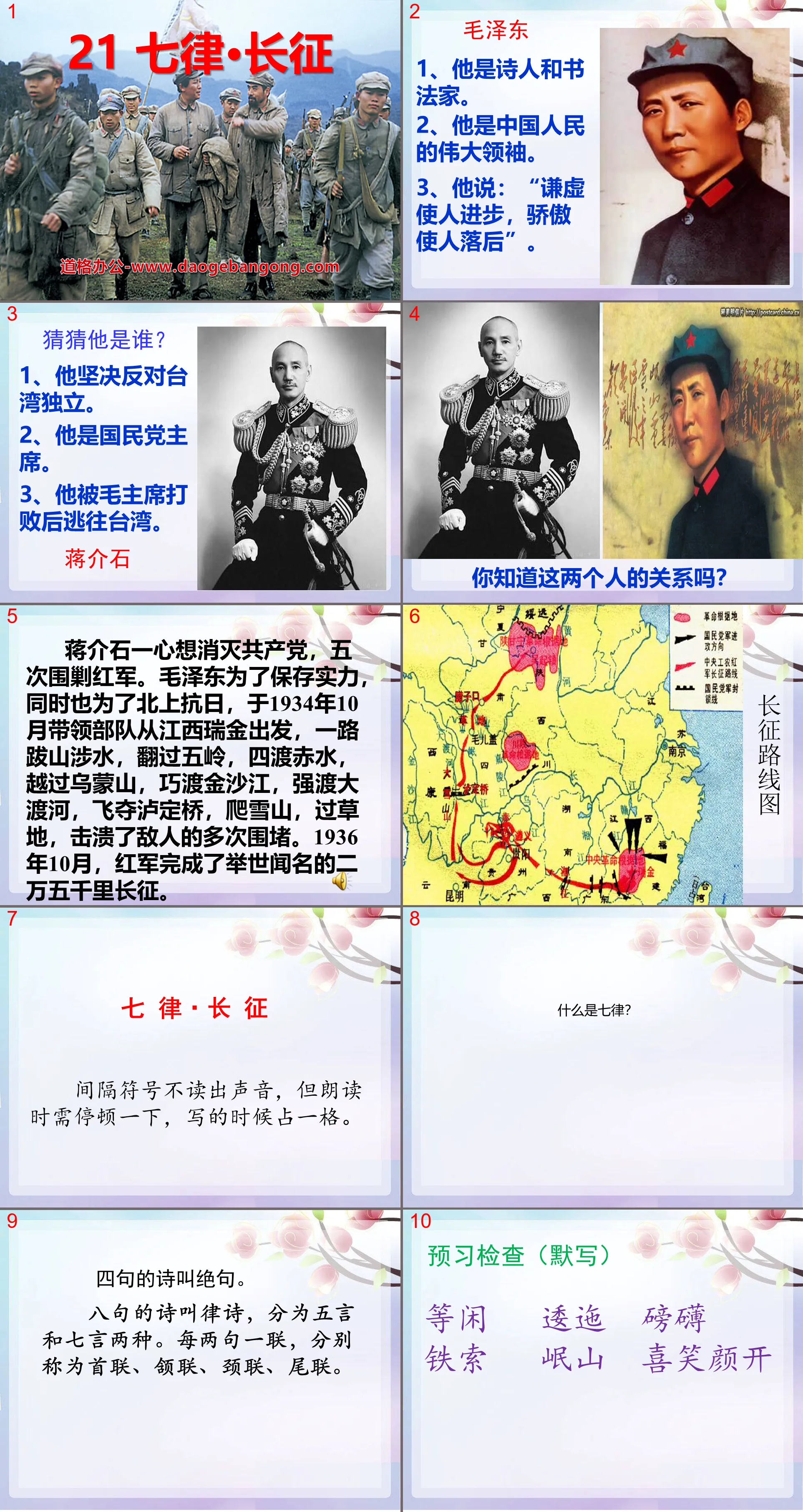"Seven Laws·Long March" PPT courseware 7 Simple campus recruitment activity planning plan summary enterprise and institution recruitment publicity lecture PPT template is a general PPT template for business post competition provided by the manuscript PPT, simple campus recruitment activity planning plan summary enterprise and institution recruitment promotion Lecture PPT template, you can edit and modify the text and pictures in the source file by downloading the source file. If you want more exquisite business PPT templates, you can come to grid resource. Doug resource PPT, massive PPT template slide material download, we only make high-quality PPT templates!
| 文件名 如何下载使用 | 下载次数 | Download Points | 下载地址 |
|---|---|---|---|
| "Seven Laws·Long March"... | 3500次 | 0.00 | Free Download |
Tips: If you open the template and feel that it is not suitable for all your needs, you can search for related content "Seven Laws·Long March" PPT courseware 7 is enough.
How to use the Windows system template
Directly decompress the file and use it with office or wps
How to use the Mac system template
Directly decompress the file and use it Office or wps can be used
Related reading
For more detailed PPT-related tutorials and font tutorials, you can view: Click to see
How to create a high-quality technological sense PPT? 4 ways to share the bottom of the box
Notice
Do not download in WeChat, Zhihu, QQ, built-in browsers, please use mobile browsers to download! If you are a mobile phone user, please download it on your computer!
1. The manuscript PPT is only for study and reference, please delete it 24 hours after downloading.
2. If the resource involves your legitimate rights and interests, delete it immediately.
3. Contact information: service@daogebangong.com
"Seven Laws·Long March" PPT courseware 7, due to usage restrictions, it is only for personal study and reference use. For commercial use, please go to the relevant official website for authorization.
(Personal non-commercial use refers to the use of this font to complete the display of personal works, including but not limited to the design of personal papers, resumes, etc.)

Related reading
For more detailed PPT-related tutorials and font tutorials, you can view:Please click to see










Authoritative PPT Summary
"Seven Laws·Long March" PPT courseware 7
I read the Long March
Read aloud freely, read the pronunciation of the words accurately, grasp the rhythm, and read the emotion and momentum.
Long March: From 1931 to 1934, under the guidance of Comrade Mao Zedong’s correct line, the Red Army achieved four great victories against “encirclement and suppression” campaigns. Later, because Wang Ming's wrong line rejected Comrade Mao Zedong's correct leadership, the fifth counter-campaign against "encirclement and suppression" failed. In October 1934, the Red Army had to leave the Central Soviet Area Base Area and set out from Changting and Ninghua in Fujian and Ruijin in Jiangxi to start the Long March and go north to fight against Japan. Other Red Army troops were also forced to leave their original base areas and began their long marches one after another. During the Long March, the Party Central Committee held the Zunyi Conference in January 1935, which reestablished Comrade Mao Zedong's leadership and ended the rule of Wang Ming's line. From then on, the Chinese revolution turned crisis into safety and moved from victory to victory.
The meaning of the Long March: The Long March is a manifesto. It proclaimed to the world that the Red Army was a hero and that the imperialists and their lackeys, Chiang Kai-shek and his ilk, were completely useless. The Long March declared the bankruptcy of imperialism and Chiang Kai-shek's pursuit and interception. The Long March was also a propaganda team. It announced to the approximately 20 million people in 11 provinces that only the path of the Red Army was the path to liberating them. Without this, how could the broad masses of the people know so quickly that there is such a great truth as the Red Army in the world? The Long March is a seeder again. It has scattered many seeds in eleven provinces, which will germinate, grow leaves, bloom, and bear fruit, and there will be a harvest in the future. All in all, the Long March ended with our victory and the enemy's defeat.
word explanation
Thousands of rivers and thousands of mountains: The words "qian" and "wan" here are general, describing countless mountains and countless waters, implying many difficulties and dangers.
Easing: It means ordinary.
Wuling: refers to five mountains, namely Yuecheng Ridge, Dupan Ridge, Mengzhu Ridge, Qitian Ridge, and Dayu Ridge. These five mountains are on the borders of the four provinces of Jiangxi, Hunan, Guangdong, and Guangxi.
Winding: winding and continuous.
Xilang: small waves.
Wumeng: refers to Wumeng Mountain, located between Yunnan and Guizhou provinces.
Majestic: majestic, here refers to tall and steep mountains.
Zuoniwan: walk, run. The little mud ball rolled quickly under my feet.
Iron cables: refers to the Luding Bridge on the Dadu River. When the Red Army crossed the bridge, there were only thirteen iron cables left.
Minshan Mountain: Located at the junction of Sichuan and Gansu, it is about 4,000 meters above sea level and covered with snow all year round.
The three armies: refers to the first, second and fourth front armies of the Chinese Workers' and Peasants' Red Army, which generally refers to the entire Red Army.
Everyone is smiling: everyone is smiling.
Let’s read this poem again and grasp the key words and phrases to feel the spirit of the Red Army soldiers.
A. The five ridges are meandering and the waves are flowing, and the Wumeng is majestic and muddy.
1. What are the comparisons between the "Wuling" Mountains and Wumeng Mountain?
The Wuling Mountains are so undulating and endless, but in the eyes of the Red Army, they are just small rolling waves; the Wumeng Mountain is so tall, majestic and majestic, but in the eyes of the Red Army, they are just like mud balls rolling under their feet.
2. What techniques are used in this poem? What kind of spirit does the poet express?
Exaggeration, suppressing first and then promoting, further highlights the greatness of the Red Army.
B. The golden sands and water are warm against the clouds and the cliffs are warm, while the iron cables across the Dadu Bridge are cold.
1. Which two stories about the Long March are told in this poem?
2. What techniques are used in this poem? What kind of feelings do the poets express by "warm" and "cold"?
The word "warm" reflects the warm weather in Yunnan in early May, and also describes the happy mood of the Red Army after they crossed the Jinsha River.
The word "Han" vividly reproduces the thrilling and tragic scene of the Red Army forcibly crossing the Dadu River, reflecting the Red Army's fighting spirit of not being afraid of bloodshed and sacrifice and marching forward bravely.
Summarize
Throughout the whole poem, this poem vividly summarizes the glorious battle history of the Red Army, enthusiastically praises the revolutionary heroism and revolutionary optimism of the Red Army of Chinese workers and peasants who are not afraid of dangers, bravery and tenacity, and expresses the various lofty sentiments of the Communist Party of China. Ambition, it is a heroic epic of the Chinese revolution and a brilliant pearl in the treasure house of Chinese poetry.
Requirements: Memorize and write the entire poem silently.
Keywords: Qilu teaching courseware, Long March teaching courseware, Hebei Education Edition fifth grade Chinese PPT courseware download, fifth grade Chinese slide courseware download, Qilu PPT courseware download, Long March PPT courseware download, .PPT format;
For more information about the "Seven Laws Long March" PPT courseware, please click the "Seven Laws ppt Long March ppt" tab.
"Seven Laws·Long March" PPT free download:
Free PPT download of "Seven Laws of the Long March" Part One: Writing Background Students, in 1933, the Kuomintang reactionaries launched their fifth encirclement and suppression campaign against the Central Revolutionary Base Area with a force of 500,000 troops. In order to crush the enemy's attack, the Workers' and Peasants' Red Army led by the Communist Party of China launched in October 1934..
"Seven Laws·Long March" PPT teaching courseware:
"Seven Laws of the Long March" PPT teaching courseware Part One: Introduction of the new course Mao Zedong, courtesy name Runzhi, was born on December 26, 1893 in a peasant family in Shaoshanchong, Xiangtan, Hunan. Died in Beijing on September 9, 1976. Leader of the Chinese people, Marxist, great...
"Seven Laws·Long March" PPT download:
"Seven Rhythms Long March" PPT Download Part One: New Lesson Introduction Students, listening to this exciting melody, we seem to hear the clanging horns and see the majestic momentum of the 25,000-mile Long March. Today we will study "Seven Rules of the Long March" together and feel the power of the Red Army...